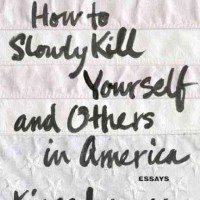“That man who is forced each day to snatch his manhood, his identity, out of the fire of human cruelty that rages to destroy it knows, if he survives his effort … something about himself … that no school on earth can teach.” So wrote James Baldwin in The Fire Next Time, preceding Mississippi-born author Kiese Laymon by 50 years. However, in this very un-post-racial world, Laymon picks up where Baldwin left off, surviving and living to tell the tale. And there is survival, despite the title of his new essay collection, How to Slowly Kill Yourself and Others in America. Laymon filters his stories through the black, male, Southern perspective in work that is stirring and fresh, literary but ultimately approachable. How does he kill himself and others? By fighting, by loving too much or not enough, by eating too much, by quitting, by writing or not writing, and by continuing to push forward despite opposition.
In the titular essay, originally published last summer on Gawker, where Laymon is a contributing editor, he recalls four incidents in which a gun was pulled on him. Laymon’s skill is drawing the reader into such depths through perfectly distilled moments in time while giving an entire analysis on institutional racism, black-on-black crime, police brutality, parental love, and mental illness. He does all of this with an ear for dialect that mirrors Toni Cade Bambara’s many Hazels or Alice Walker’s Celie, and with an ability to reveal the humanity in everyone he writes about, reminiscent of Edward P. Jones’ Lost in the City. “I wanted to explore the benefits and burdens of being born a black boy in America without the predictable literary rigidity,” Laymon said in the author’s note.
Laymon’s essays, though slim, pack myriad emotions and examinations of emotional death. The writing is strong throughout; he seldom wastes an explanation or metaphor. Though the blues impulse is present, he raps familiar, like an older brother. His pieces tend to reach a gospel crescendo, like a preacher. Many of the essays also read as latent apologies for earlier slights or misunderstandings. Only in hindsight can people see the ways in which they were killing themselves and others around them. In “Prologue: We Will Never Ever Know, Letters to Uncle Jimmy,” he apologizes to his grandmother’s son, who was struggling with addiction, for turning him into a shadow of a stereotype that he could use for storytelling, instead of granting him his humanity. “The Worst of White Folks” starts with a “playing-fart-games-in-church whupping” and ends with an actual death. The leap from a single incident to the “worst of white folks” is his understanding that as a black man, his behavior must be beyond reproach. Black people growing up in Mississippi had a keen understanding that the worst of white folks could drag you out of your home for no reason other than boredom and hang you from a tree, expel you from school, rape your sisters, or put you in jail.
Laymon situates himself as a brother, cousin, friend, son at all times, because, as several of the essays evince, he has experienced enough racism to know that on first glance race may be the only context through which he is glimpsed. But he also touches on invisibility in places where he might have expected community. In “Hip Hop Stole My Southern Black Boy,” Laymon talks about how the dominance of New York and California hip hop initially overshadowed and erased whatever regional pride and stories he wanted to tell. But at the turn of the century, the South became such a huge part of the sound and culture that everyone had to pay attention. “I’m not sure that what Mississippi artists are saying today is the most meaningful work in the world. I know that it is the most meaningful work in my world. And without the historic and contemporary sounds, sayings, and doings of Southern black boys … and Southern black girls … hip-hop and American art would be sleek, conventional, heady, pallid, and paltry as the blank piece of paper in the last page of this book. … Can you hear us?” he asks.
The best and final essay, also published previously on Gawker, “You Are the Second Person,” follows a writer who trying to get a young-adult novel published that involves time travel, civil rights, and black kids, questioning what it means to be “a real black writer.” It involves a much-needed roast of the publishing industry but it also reveals the inner life of a writer who is trying to tell a personal story in a world that either doesn’t want to hear it, or only wants a very specific narrative. Despite a disclaimer at the top of the piece proclaiming it fictional, Laymon released a YA novel with a similar theme, Long Division, earlier this summer.
This is a meaningful place to end the collection—a hopeful note suggests that after finding out the ways in which they can kill themselves slowly, people can also find their way toward rebirth, casting the author’s experience as quintessentially American. Laymon’s essays show he understands what Baldwin means when the latter says “in order to save his life, he is forced to look beneath appearance, to take nothing for granted, to hear the meaning behind the words.”




